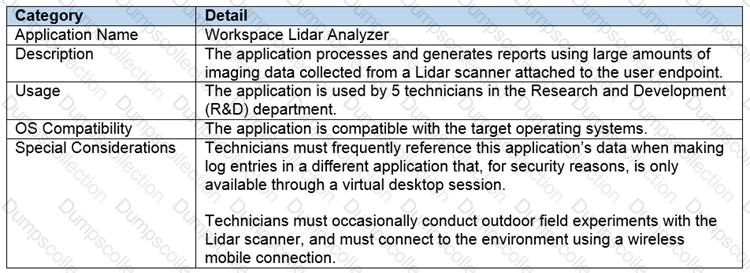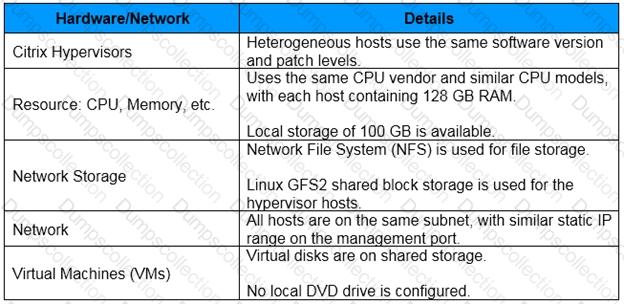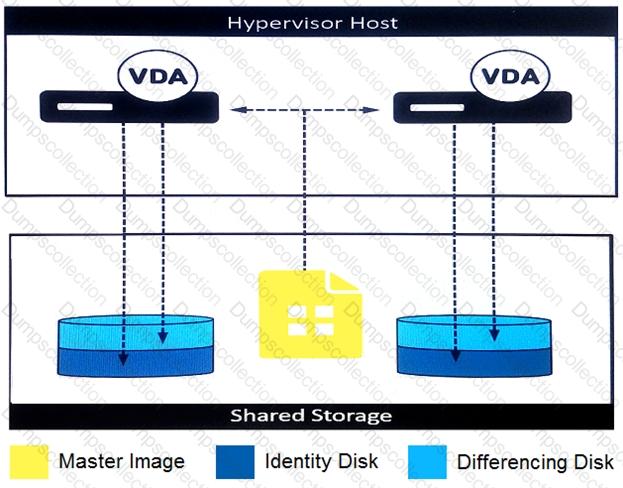Citrix Citrix Virtual Apps and Desktops 7 Assessment Design and Advanced Configurations 1Y0-403 Exam Dumps: Updated Questions & Answers (November 2025)
Scenario: A Citrix Architect is designing a new Citrix Virtual Apps and Desktops environment. The customer previously installed all applications locally on managed laptops and desktops but is willing to evaluate other application delivery methods as part of the new deployment. The environment will be standardized on Windows 10 and Windows Server 2016 for the Virtual Delivery Agent (VDA) machines.
As part of an application analysis performed earlier in the project, the information in the exhibit was collected regarding 1 of the required applications.
Click the Exhibit button to view the information.

The customer has the additional objective of minimizing the amount of network traffic in the environment, particularly on WAN or metered links.
How should the architect deploy the application?
Scenario: A Citrix Architect needs to manage the disaster recovery (DR) process for a Citrix Virtual Apps and Desktops environment. The environment currently consists of an active data center typically accessed by users, and a DR data center used in the event that a disaster impacts the primary data center. Management has made it a priority to minimize the loss of data when failing over between data centers.
The environment has failed over from the primary data center to the DR data center and the primary data
center has subsequently been recovered to its normal state.
What is the appropriate sequence of steps that the architect should follow to return to normal operations after the primary data center’s stability is confirmed?
A Citrix Architect is designing a new Citrix Virtual Apps and Desktops environment. The IT team maintains 12 Citrix Hypervisor hosts that are available to build the new Citrix environment. During the project kickoff meeting, management states:
“We need a robust infrastructure that can handle large user loads, improve IT efficiency, guarantee minimal downtime, and protect the network and its resources from corruption.”
Click the Exhibit button to view the existing infrastructure details.

Which configuration should the architect use to meet the requirements for the new Citrix environment?
Scenario: A Citrix Architect is creating a conceptual architecture for a Citrix Virtual Apps and Desktops environment. Based on some initial discussions around the company’s business goals and objectives, the architect collected the information shown in the exhibit.
Click the Exhibit button to view the information.

Which delivery model should the architect recommend?
Scenario: A Citrix Architect is designing a new Citrix Virtual Apps and Desktops environment. As part of graphics-mode design considerations, the architect discovered that one User Group requires a graphics mode that provides both good performance and high image quality.
Which graphics mode should the architect recommend be configured for this specific group?
Scenario: A Citrix Architect designing a new Citrix Virtual Apps and Desktops environment needs to determine which endpoints to include. Based on discussions with various departments, the user requirements listed in the exhibit were collected.
Click the Exhibit button to view the requirements.

Which endpoint type should the architect use for the Customer Service Group, based on the requirements?
Scenario: A Citrix Architect is redesigning a Citrix Virtual Apps and Desktops environment to include Machine Creation Services (MCS). During design discussions, the locations for the MCS-provisioned thin clone machine disks are proposed as shown in the exhibit.
Click the Exhibit button to view the details.

Which two potential issues should the architect address with the customer before proceeding with this configuration? (Choose two.)
Scenario: A Citrix Architect is designing and implementing a new Citrix Virtual Apps and Desktops environment. During the kickoff meeting, management advised that their main business driver is to increase user flexibility for internal and mobile employees.
Which two design decisions should the architect make based on the listed business drivers? (Choose two.)
Scenario: An additional zone was recently added to a Citrix Virtual Apps and Desktops environment. The main zone is located in New York City, and a small, second zone is located in Tokyo. Within the next year, the number of users in Tokyo is expected to equal that in New York City.
A Citrix Architect recommended the addition of 2 StoreFront servers in Tokyo to support the users.
What should the architect recommend for this environment to ensure user-experience consistency and reduce WAN bandwidth consumption?
Scenario: A Citrix Architect is designing a new Citrix Virtual Apps and Desktops environment. Management has requested dynamic distribution of users between the primary and backup data centers to ensure that all available hardware is utilized during normal operations.
What is the biggest risk the architect should highlight to the customer when designing the profile strategy?

